Escaping The Wrist Grab
Part 1 – From The Same Side
by Christopher Caile
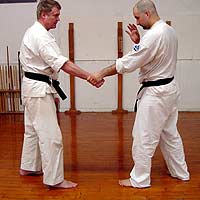
Wrist grabs are a basic attack. They are found in aikido, jujutsu systems and daito-ryu aikijutsu. And they are taught as part of self-defense in most karate systems and within self-defense courses.
At one time self-defense and escape techniques from wrist grabs, pins or pulls were critical to survival. In medieval times the primary weapon was a knife and/or a sword or swords –carried in easy access through a belt, in a scabbard or elsewhere on the body. Incapacitating a wrist could stop a weapon from being withdrawn, or provide a critical second of incapacitation for an attacker to use his or her weapon. Martial arts that were developed prior to the 20th century thus naturally incorporated a variety of wrist attacks and other manipulations.
Today, however, wrist grabs rarely relate to weaponry unless the weapon is a beer bottle, club or baseball bat. More often than not, today assailants use wrist grabs for control, usually by a much larger, stronger person against a smaller weaker one — such as a male assailant pulling a women or a child, or a parent controlling an offspring. Of course, in many martial arts the wrist and elbow might be grabbed for an arm manipulation after a strike, but this is a different story.
This series will explore a variety of simple wrist grabs, from the same side, from across the body and two hand grabs. This first article will examine the simple front wrist grab such as an attacker’s left hand grabbing the right wrist of someone. The escapes here demonstrated are simple and effective. They are also compared. Because of space many techniques common to aikido and/or jujutsu systems have not been discussed.
First, let it be said that there are a literally hundreds of possible escapes and self-defense techniques that are taught and practiced. Some, however, are better than others. And what is used is also dictated by the attack — a static grab and hold versus a grab and pull. What works in one situation doesn’t necessarily work in another.
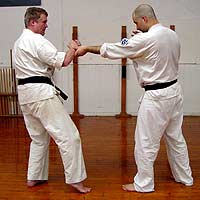 One of the most common defenses (shown here) is to use your free hand to grab the top of your fist and then pull back against the attacker’s grip and in particular against the attacker’s thumb — the weak link in most wrist grabs. The advantage in this defense is that in pulling back you also pull the attacker’s shoulder forward which can inhibit a punch by the other arm. Also, as you sink back you can move your weight to back foot, allowing a front snap kick (not shown) by your front foot. From this position you can also easily run away.
One of the most common defenses (shown here) is to use your free hand to grab the top of your fist and then pull back against the attacker’s grip and in particular against the attacker’s thumb — the weak link in most wrist grabs. The advantage in this defense is that in pulling back you also pull the attacker’s shoulder forward which can inhibit a punch by the other arm. Also, as you sink back you can move your weight to back foot, allowing a front snap kick (not shown) by your front foot. From this position you can also easily run away.
There are a couple of disadvantages to this technique, however. If the defender is small and significantly weaker, the pull back might not be sufficient to break free. In addition, if the attacker is pulling in, a weak pull back might actually propel the defender further into the attack instead of breaking free. And of course, this technique still leaves the defender in front of the assailant and open to a potential strike or attack by the other arm. If you pull back, even if you free yourself from the attacker’s grip and don’t continue to distance yourself further, your movement backward unfortunately places you at perfect kicking range of the attacker.
 Another, and slightly different, self-defense is instead of pulling back, to first rotate your wrist and arm so as to turn the attacker’s wrist so the palm is up and the elbow is down.
Another, and slightly different, self-defense is instead of pulling back, to first rotate your wrist and arm so as to turn the attacker’s wrist so the palm is up and the elbow is down.
As a test, rotate your own arm in this way (a position common to an inside or outside block in karate). Notice how there comes a point that neither the wrist nor arm can rotate any further. This is the position that you want to move your attacker’s arm into. It is also simple to do. The attacker is not concentrating on this directional move (as he or she would be with a pull back). Additionally the muscles involved are not very powerful. If you combine your arm turn with a kiai (shout) or defensive movement with your free hand, the opponent’s concentration will be broken and the movement will be easier to do.
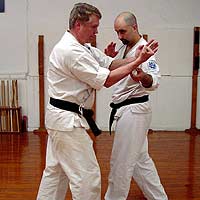
As you turn your arm over, support your fist with the palm of your free arm and then step forward (here, with the right foot) to the side of the attacker. This allows you to use your whole body weight against the thumb of the attacker’s gripping hand that, along with the arm, is locked in position by the preceding move.
Here you are not expending muscle power against muscle power, but instead letting your body’s weight and movement do the work. And if you want to counter attack, you can raise your left elbow (not shown) to do an elbow attack against the attacker’s head or face.
Their are several benefits of this technique. It takes less strength. It can be done if the attacker is pulling in, and it can also incorporate a counter attack (elbow to face or head). A disadvantage, however, is that the defender is still potentially open to a strike or other offensive technique from the attacker’s free arm. A kick is less likely, however, since you have maneuvered to the attacker’s side.
Both of the techniques shown above allow a defender to break free. Both, however, are vulnerable to an attack from the assailant’s free arm and neither establishes control over the attacker. For this reason I personally favor a self-defense technique similar to that seen in many renditions of the karate kata Saiha. I was shown one such technique while researching kata applications on Okinawa. It is illustrated below.

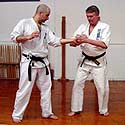

As soon as the opponent grabs your wrist, you begin to step forward with your right foot as you pivot to the outside around the attacker’s grasping wrist. This is also a basic defensive move in aikido that allows you to get to the outside of the attacker and lead the attack.
The Saiha kata move, however, is somewhat different. In this application you support your own arm with your other hand. This turns your opponent’s wrist over into a similar position as done in the technique above, but it also moves you away from any potential attack by the assailant’s other fist while manipulating the assailants arm so it is impossible (unless he lets go) of turning towards you to attack. Notice (close up) how the attacker’s wrist moves inward (hand outward) which forces the attacker’s elbow inward and restricts body movement.
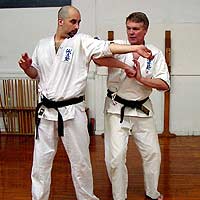 As you continue to rotate, snap your own elbow (with your whole body weight behind it) against the outside/bottom of the attacker’s elbow. If done with a quick snapping action this movement will damage your attacker’s elbow, or break it, before the arm pops upward and away from you — so be very careful when practicing this technique. The attacker’s left wrist will now be close to your own left hand and within easy reach. Grab the attacker’s wrist.
As you continue to rotate, snap your own elbow (with your whole body weight behind it) against the outside/bottom of the attacker’s elbow. If done with a quick snapping action this movement will damage your attacker’s elbow, or break it, before the arm pops upward and away from you — so be very careful when practicing this technique. The attacker’s left wrist will now be close to your own left hand and within easy reach. Grab the attacker’s wrist.
Once you have grabbed the attacker’s wrist drop backward into a horse stance. Don’t step. By releasing your left knee and letting your weight drop, your can let your weight pull the opponent’s arm down, and with it the head will be pulled forward, allowing you to strike with a right backfist to the chin or face of your attacker (that drives the head backward). Here you have both taken control of your attacker while simultaneously mounting a counter attack.
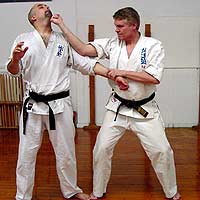
This dropping motion that lets gravity do the work, and that uses muscles only to halt movement (rather than generate it), is one of the forgotten secrets used by some of the old karate masters. It was also the basis of the traditional body movement underlying the Japanese Samurai tradition. (1)
This technique has the advantage of movement away from a second offensive technique, of using your own weight and movement to achieve an escape, while also (if desired) being able both to take control of the opponent and mount a counter attack — all as part of one quick and powerful movement sequence.
A variation of this techniques involves how the defender can react in case the attacker is somehow is able to punch at you with his right fist? Eiichi Miyazato (the Okinwan master who was one of the prime students of Chojun Miyagi’s Goju-ryu karate system) showed me how at this point your left arm could be extended to intercept and block this attack (instead of grabbing the left arm as is illustrated) while at the same time doing the same backfist to the attacker’s face.
This article can only touch on several viable alternative self-defense techniques that can be used against the wrist grab. If you have another application that you think is practical, you can send it to FightingArts.com through the Comments section following this article.
Footnote:
(1) In Hakuhokai Daito-Ryu Aikijujutsu (Daito-Ryu, a jujutsu system, being one of, if the oldest, of Japan’s continually practiced martial arts systems) which incorporates within its teaching curriculum the Aizu (Japanese Clan through which Daito-Ryu was transmitted) sword art, Ona Ha Itto Ryu Kenjutsu, the founder Okabayashi Shogen emphasizes this method of moving the body and transmitting force without the use of strength. This method of body movement, common to pre-Meiji era (pre-1868) martial arts, was based on high level techniques developed for cutting and stabbing with the sword. Aikido inherited this concept from Daito-Ryu. Although this method of body movement is used in a much more restricted method, in Aikido it is a principle concept of the art. Likewise, some of this concept of movement was incorporated into the karate that developed on Okinawa and is still taught in some systems, such as in Okinawa Karate Do Shorin Ryu Kishaba Juku. Joe Swift, the well-known karate historian and Associate Editor of FightingArts.com, has translated a book by Matsuo Kanenori Sakon Sensei, “Ryukyu ke Hiden Bujutsu” in which the author notes this same concept of movement within old Okinawan karate. In my own Seido Juku karate system founded by Kaicho Tadashi Nakamura, Nakamura uses this same dropping of the body method when moving back into a horse stance for this technique, as illustrated above.

About the Author Christopher Caile
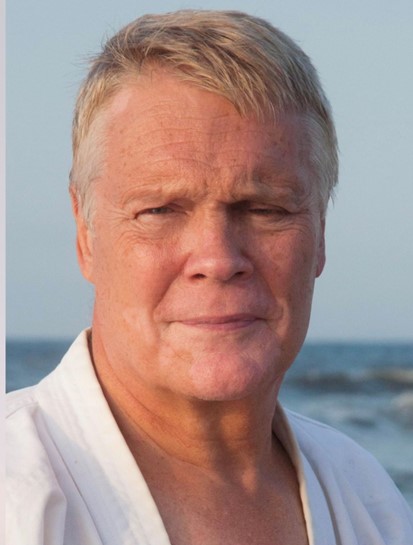
Christopher Caile
Christopher Caile is the Founder and Editor-In-Chief of FightingArts.com. He has been a student of the martial arts for over 65 years.
He first started in judo while in college. Then he added karate as a student of Phil Koeppel in 1959 studying Kempo and Wado-Ryu karate. He later added Shotokan Karate where he was promoted to brown belt and taught beginner classes. In 1960 while living in Finland, Caile introduced karate to that country and placed fourth in that nation’s first national judo tournament.
Wanting to further his karate studies, Caile then hitch hiked from Finland to Japan traveling through Scandinavia, Europe, North Africa, the Middle East and South and Southeast Asia — living on 25 cents a day and often sleeping outside.
Arriving in Japan (1962), Caile was introduced to Mas Oyama and his fledgling full contact Kyokushinkai Karate by Donn Draeger, the famous martial artist and historian. Donn also housed him with several other senior international judo practitioners. Donn became Caile’s martial arts mentor, coaching him in judo and introducing him to Shinto Muso-ryu under Takaji Shimizu.
Caile studied at Oyama’s honbu dojo and also at Kenji Kurosaki’s second Tokyo Kyokushinkai dojo. In his first day in class Oyama asked Caile to teach English to his chief instructor, Tadashi Nakamura. They have been friends ever since. Caile also participated in Oyama’s masterwork book, “This Is Karate.”
Caile left Japan with his black belt and designation as Branch Chief, the first in the US to have had extensive training in Japan directly under Oyama Sensei. As such, Oyama Sensei asked him to be his representative on visits to his US dojos to report on their status.
A little over a year later, Nakamura, Kusosaki and Akio Fujihira won an epic David vs. Goliath challenge match against Thailand’s professional Muay Thai Boxers in Bangkok, Thailand, thrusting Kyolushinkai and Nakamura into national prominence.
Back in the US Caile taught Kyokushinkai karate in Peoria, Il while in college and later in Washington, DC. while in graduate school. Durimg this time Shihan Nakamura had moved to New York City to head Kyokushinkai’s North American Operation.
In 1976 when Kaicho Tadashi Nakamura formed the World Seido Karate organization, Caile followed. Living then in Buffalo, NY, Caile taught Seido karate and self-defense at the State University of New York at Buffalo (SUNY Buffalo) for over 15 years where he also frequently lectured on martial arts and Zen in courses on Japanese culture.
Caile moved to New York City in 1999 to marry Jackie Veit. He is now an 8th degree black belt, Hanshi, training in Seido Karate’s Westchester, NY Johshin Honzan (Spiritual Center) dojo. In Seido Caile is known for his teaching of and seminars on kata applications. He also produced a 14 segment video series on Pinan kata Bunkai currently available to Seido members.
Caile is also a long-time student and Shihan in Aikido. He studied in Buffalo, under Mike Hawley Shihan, and then under Wadokai Aikido’s founder, the late Roy Suenaka (uchi deshi under Morihei Ueshiba, founder of Aikido and was Shihan under Tohei Sensei). In karate, Suenaka (8thdan) was also an in-house student of the Okinawan karate master Hohan Soken.
Having moved to New York City, Caile in 2000 founded this martial arts educational website, FightingArts.com. Twenty-five years later, in 2025, it underwent a major update and revision.
For FightingArts.com and other publications Caile wrote hundreds of articles on karate, martial arts, Japanese art, Chinese Medicine and edited a book on Zen. He also developed relationships with a cross section of leading martial arts teachers. Over the last four decades he has conducted extensive private research into karate and martial arts including private translations of the once secret Okinawan hand copied and passed on Kung Fu book, the Bubishi, as well as an early karate book by the karate master Kenwa Mabuni. He periodically returns to Japan and Okinawa to continue his studies and participate Seido karate events. In Tokyo he practiced (with Roy Suenaka Sensei) in a variety of aikido organizations with their founders – including private interviews and practices at the Aiki-kai Aikido Honbu dojo with the son and grandson of aikido’s founder, Doshu (headmaster) Kisshomaru (an old uchi-deshi friend) and his son, Moriteru Ueshiba and in Iwama with Morihiro Saito. On Okinawa he studied Goju Ryu karate under Eiichi Miyazato, 10th dan founder of Naha’s Jundokan, and also with Yoshitaka Taira (who later formed his own organization, who specialized in kata Bunkai. While there Caile also trained with Hohan Soken’s senior student, Master Fusei Kise, 10 dan as well as with the grandson of the legendary karate master Anko Itosu.
Caile’s other martial arts experience includes: Diato-ryu Aikijujitsu and Kenjitsu, kobudo, boxing, Muay Thai, MMA, Kali (empty hand, knife and bolo), study of old Okinawan Shoran-ryu & Tomari body mechanics, study of old Okinawan kata under Richard Kim, study of close quarter defense and combat, including knife and gun defenses, Kyusho Jitsu and several Chinese fighting arts including 8 Star Praying Mantis, Pak Mei (White Eyebrow), and a private family system of Kung Fu.
Caile is also a student of Zen as well as a long-term student of one branch of Traditional Chinese Medicine, Chi Kung (Qigong). As one of two senior disciples of Chi Kung master Dr. Shen (M.D., Ph.D.) Caile was certified to teach and practice. This led to Caile’s founding of the The Chi Kung Healing Institute on Grand Island, NY. In Western NY, he also frequently held Chi Kung seminars, including at SUNY Buffalo and at the famous Chautauqua Institution in Chautauqua, NY. His articles on Chi Kung also appeared in the Holistic Health Journal and in several books on alternative medicine.
Caile holds a BA in International Studies from Bradley University and MA in International Relations with a specialty in South and Southeast Asia from American University in Washington, D.C. While in Buffalo, NY he also studied digital and analog electronics.
In his professional life Caile also worked in public relations and as a newspaper reporter and photographer. Earlier he worked in the field of telecommunications including Managing a Buffalo, NY sales and service branch for ITT. He then founded his own private telephone company. This was followed by creation of an electrical engineering company that designed and patented his concept for a new type of low-cost small business telephone system (which was eventually sold to Bell South). The company also did contract work for Kodak and the US space program. Simultaneously Caile designed and manufactured a unique break-apart portable pontoon boat.
Most recently Caile co-founded an internet software company. Its products include software suites with AI capability for control and management of streaming media, such as video and music, an all-in-one book publishing software product for hardcover, eBook and audio book creation and security software for buildings and government use.
For more details about Christopher Caile’s martial arts, work experience and life profile, see the About section in the footer of this site.
Search for more articles by this author:






